Film Archival and Preservation: American Film Institute Archive
VerifiedAdded on 2023/06/12
|8
|2226
|490
AI Summary
This article discusses the film archival and preservation strategies of American Film Institute Archive. It emphasizes the importance of film preservation and how it is executed. The article also talks about the history of film archival and the need for it. The American Film Institute Archive is dedicated to preserving and archiving the history of motion pictures. The article also discusses the strategies and execution of film preservation and archival.
Contribute Materials
Your contribution can guide someone’s learning journey. Share your
documents today.
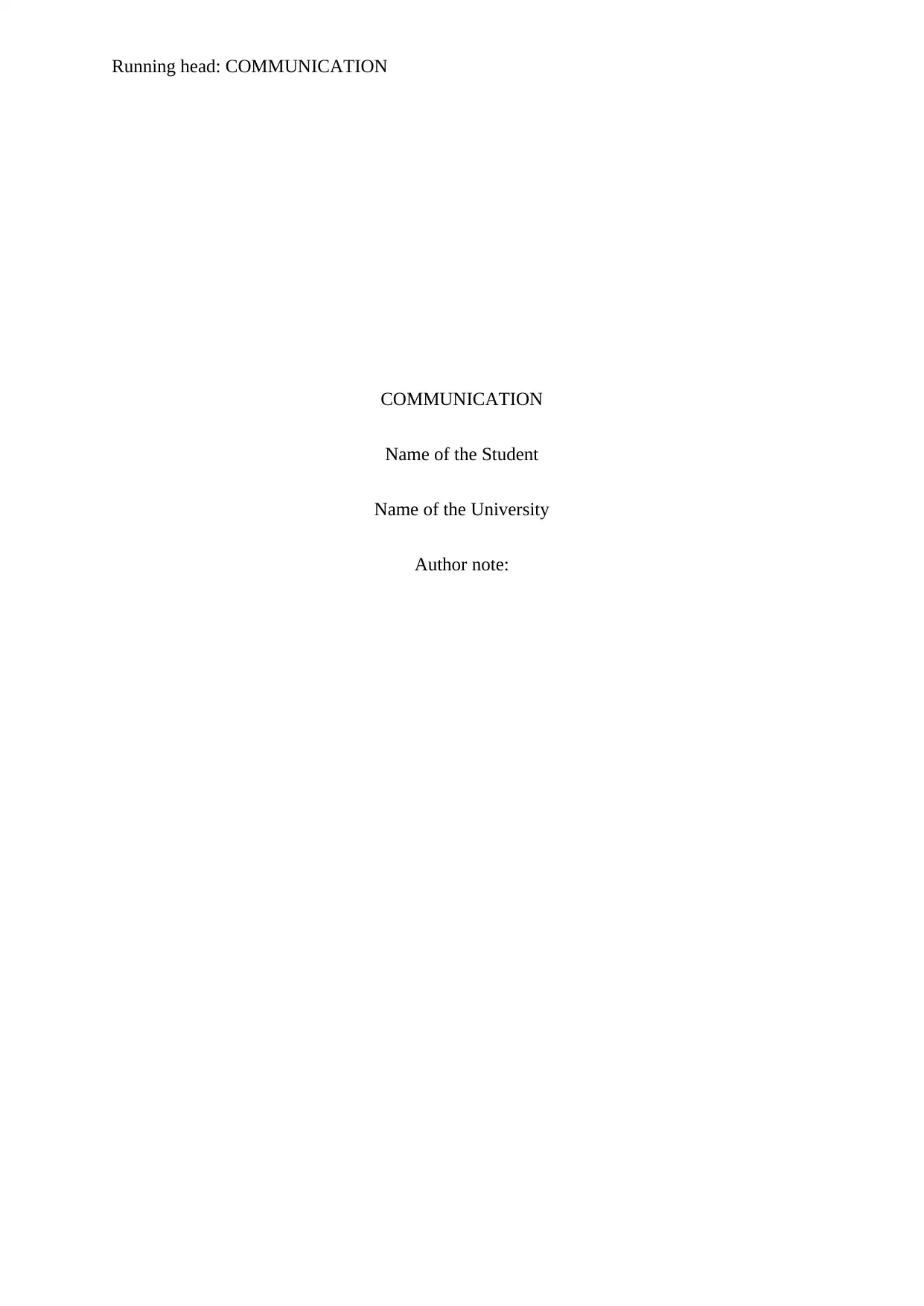
Running head: COMMUNICATION
COMMUNICATION
Name of the Student
Name of the University
Author note:
COMMUNICATION
Name of the Student
Name of the University
Author note:
Secure Best Marks with AI Grader
Need help grading? Try our AI Grader for instant feedback on your assignments.
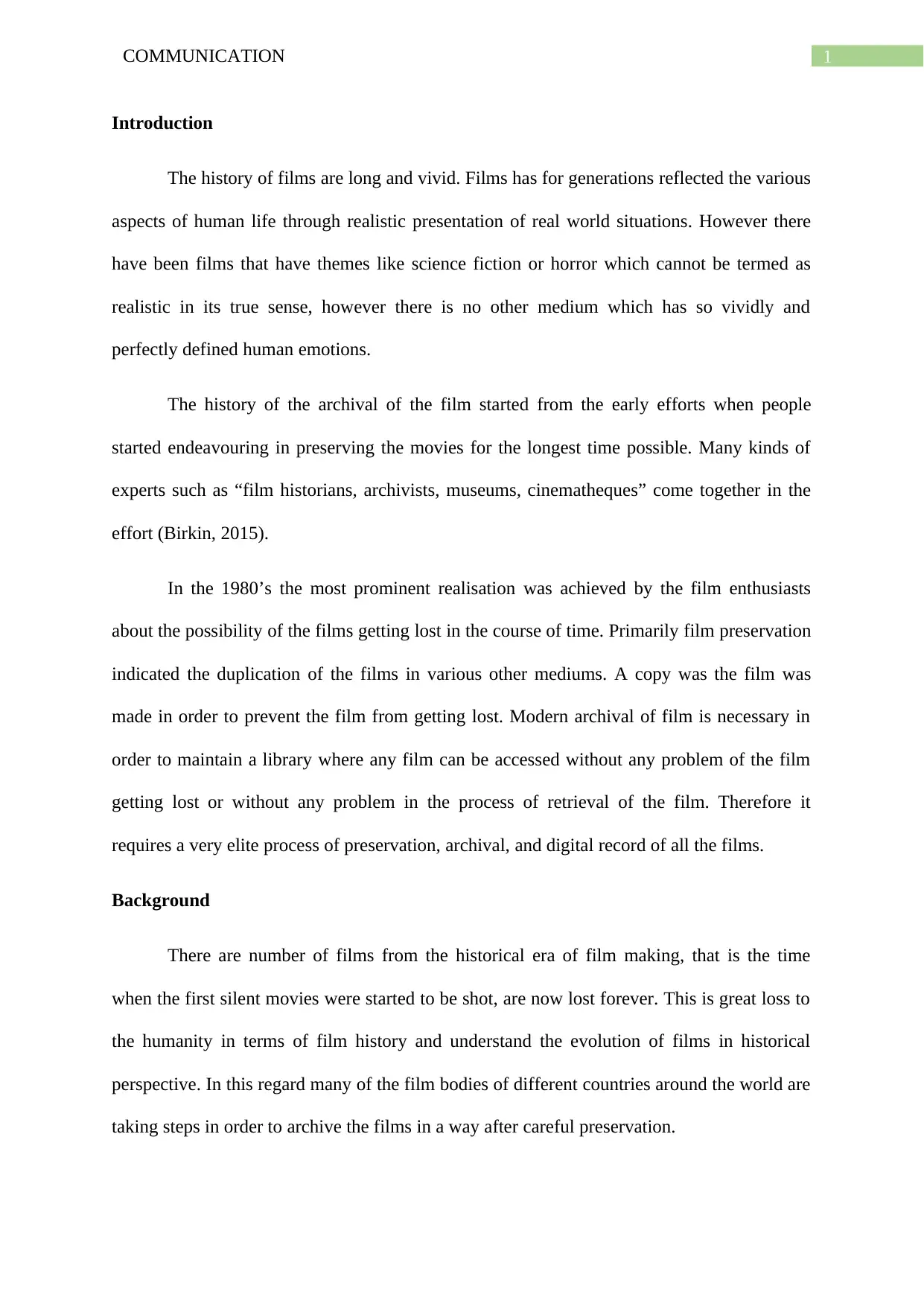
1COMMUNICATION
Introduction
The history of films are long and vivid. Films has for generations reflected the various
aspects of human life through realistic presentation of real world situations. However there
have been films that have themes like science fiction or horror which cannot be termed as
realistic in its true sense, however there is no other medium which has so vividly and
perfectly defined human emotions.
The history of the archival of the film started from the early efforts when people
started endeavouring in preserving the movies for the longest time possible. Many kinds of
experts such as “film historians, archivists, museums, cinematheques” come together in the
effort (Birkin, 2015).
In the 1980’s the most prominent realisation was achieved by the film enthusiasts
about the possibility of the films getting lost in the course of time. Primarily film preservation
indicated the duplication of the films in various other mediums. A copy was the film was
made in order to prevent the film from getting lost. Modern archival of film is necessary in
order to maintain a library where any film can be accessed without any problem of the film
getting lost or without any problem in the process of retrieval of the film. Therefore it
requires a very elite process of preservation, archival, and digital record of all the films.
Background
There are number of films from the historical era of film making, that is the time
when the first silent movies were started to be shot, are now lost forever. This is great loss to
the humanity in terms of film history and understand the evolution of films in historical
perspective. In this regard many of the film bodies of different countries around the world are
taking steps in order to archive the films in a way after careful preservation.
Introduction
The history of films are long and vivid. Films has for generations reflected the various
aspects of human life through realistic presentation of real world situations. However there
have been films that have themes like science fiction or horror which cannot be termed as
realistic in its true sense, however there is no other medium which has so vividly and
perfectly defined human emotions.
The history of the archival of the film started from the early efforts when people
started endeavouring in preserving the movies for the longest time possible. Many kinds of
experts such as “film historians, archivists, museums, cinematheques” come together in the
effort (Birkin, 2015).
In the 1980’s the most prominent realisation was achieved by the film enthusiasts
about the possibility of the films getting lost in the course of time. Primarily film preservation
indicated the duplication of the films in various other mediums. A copy was the film was
made in order to prevent the film from getting lost. Modern archival of film is necessary in
order to maintain a library where any film can be accessed without any problem of the film
getting lost or without any problem in the process of retrieval of the film. Therefore it
requires a very elite process of preservation, archival, and digital record of all the films.
Background
There are number of films from the historical era of film making, that is the time
when the first silent movies were started to be shot, are now lost forever. This is great loss to
the humanity in terms of film history and understand the evolution of films in historical
perspective. In this regard many of the film bodies of different countries around the world are
taking steps in order to archive the films in a way after careful preservation.
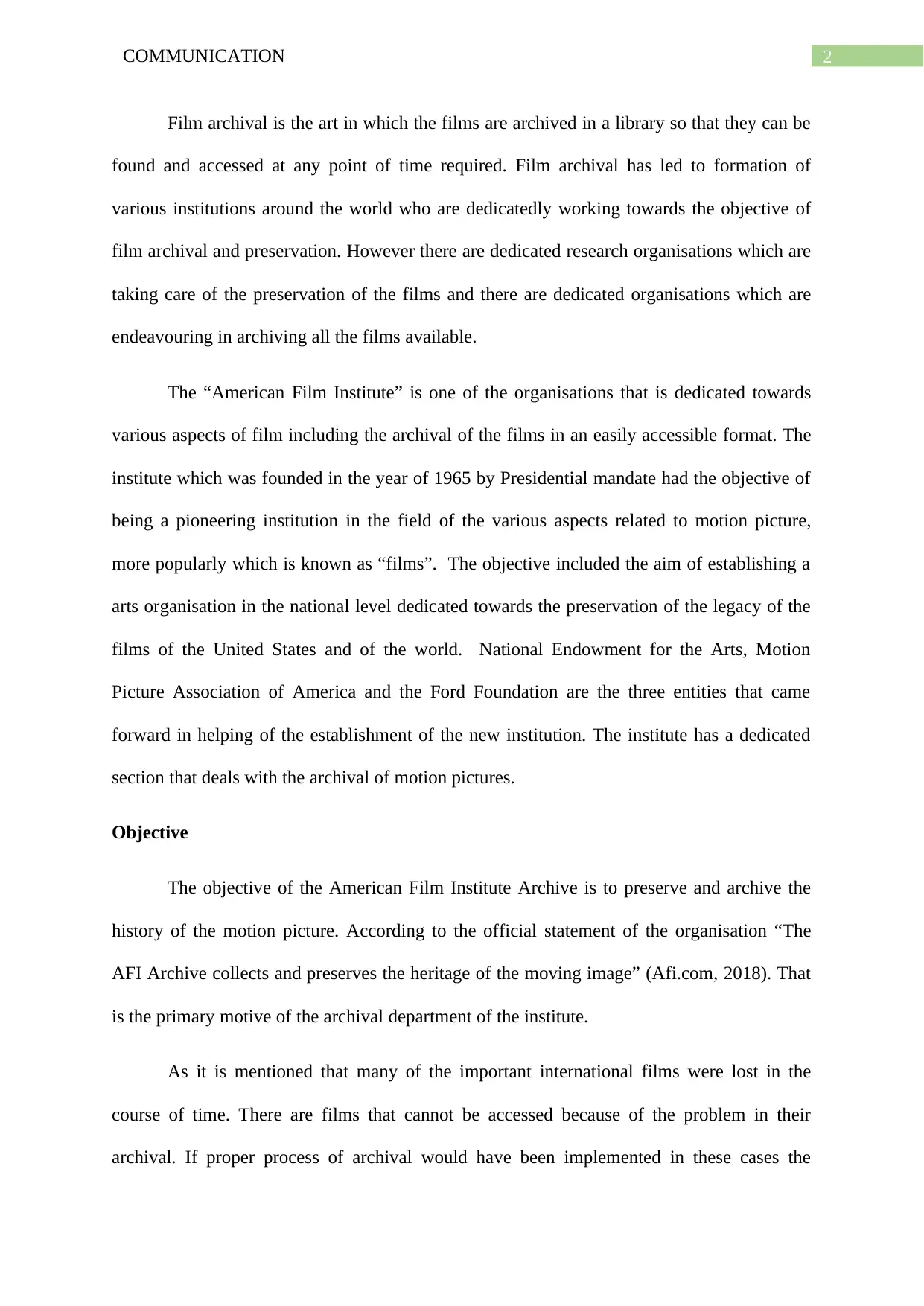
2COMMUNICATION
Film archival is the art in which the films are archived in a library so that they can be
found and accessed at any point of time required. Film archival has led to formation of
various institutions around the world who are dedicatedly working towards the objective of
film archival and preservation. However there are dedicated research organisations which are
taking care of the preservation of the films and there are dedicated organisations which are
endeavouring in archiving all the films available.
The “American Film Institute” is one of the organisations that is dedicated towards
various aspects of film including the archival of the films in an easily accessible format. The
institute which was founded in the year of 1965 by Presidential mandate had the objective of
being a pioneering institution in the field of the various aspects related to motion picture,
more popularly which is known as “films”. The objective included the aim of establishing a
arts organisation in the national level dedicated towards the preservation of the legacy of the
films of the United States and of the world. National Endowment for the Arts, Motion
Picture Association of America and the Ford Foundation are the three entities that came
forward in helping of the establishment of the new institution. The institute has a dedicated
section that deals with the archival of motion pictures.
Objective
The objective of the American Film Institute Archive is to preserve and archive the
history of the motion picture. According to the official statement of the organisation “The
AFI Archive collects and preserves the heritage of the moving image” (Afi.com, 2018). That
is the primary motive of the archival department of the institute.
As it is mentioned that many of the important international films were lost in the
course of time. There are films that cannot be accessed because of the problem in their
archival. If proper process of archival would have been implemented in these cases the
Film archival is the art in which the films are archived in a library so that they can be
found and accessed at any point of time required. Film archival has led to formation of
various institutions around the world who are dedicatedly working towards the objective of
film archival and preservation. However there are dedicated research organisations which are
taking care of the preservation of the films and there are dedicated organisations which are
endeavouring in archiving all the films available.
The “American Film Institute” is one of the organisations that is dedicated towards
various aspects of film including the archival of the films in an easily accessible format. The
institute which was founded in the year of 1965 by Presidential mandate had the objective of
being a pioneering institution in the field of the various aspects related to motion picture,
more popularly which is known as “films”. The objective included the aim of establishing a
arts organisation in the national level dedicated towards the preservation of the legacy of the
films of the United States and of the world. National Endowment for the Arts, Motion
Picture Association of America and the Ford Foundation are the three entities that came
forward in helping of the establishment of the new institution. The institute has a dedicated
section that deals with the archival of motion pictures.
Objective
The objective of the American Film Institute Archive is to preserve and archive the
history of the motion picture. According to the official statement of the organisation “The
AFI Archive collects and preserves the heritage of the moving image” (Afi.com, 2018). That
is the primary motive of the archival department of the institute.
As it is mentioned that many of the important international films were lost in the
course of time. There are films that cannot be accessed because of the problem in their
archival. If proper process of archival would have been implemented in these cases the
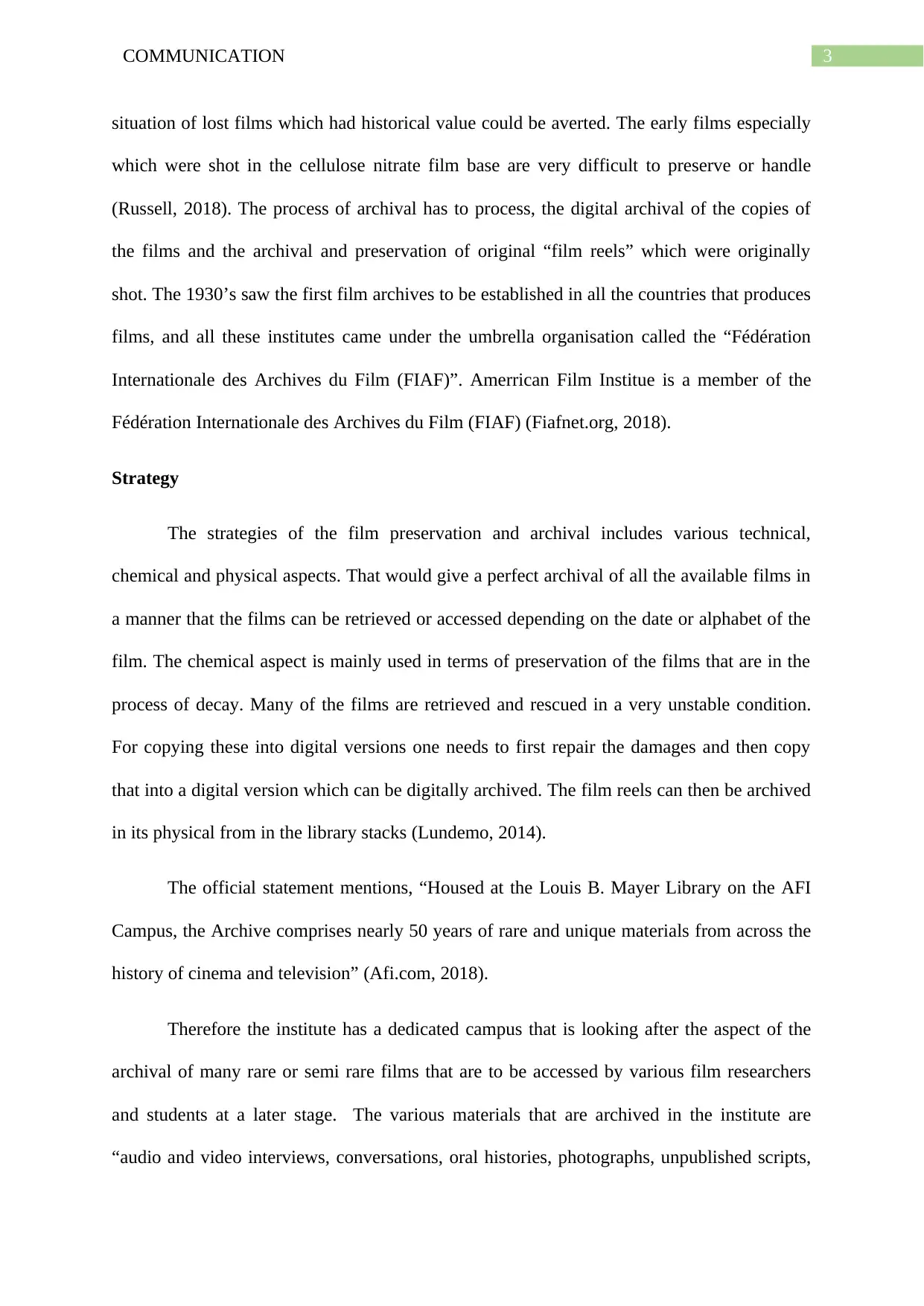
3COMMUNICATION
situation of lost films which had historical value could be averted. The early films especially
which were shot in the cellulose nitrate film base are very difficult to preserve or handle
(Russell, 2018). The process of archival has to process, the digital archival of the copies of
the films and the archival and preservation of original “film reels” which were originally
shot. The 1930’s saw the first film archives to be established in all the countries that produces
films, and all these institutes came under the umbrella organisation called the “Fédération
Internationale des Archives du Film (FIAF)”. Amerrican Film Institue is a member of the
Fédération Internationale des Archives du Film (FIAF) (Fiafnet.org, 2018).
Strategy
The strategies of the film preservation and archival includes various technical,
chemical and physical aspects. That would give a perfect archival of all the available films in
a manner that the films can be retrieved or accessed depending on the date or alphabet of the
film. The chemical aspect is mainly used in terms of preservation of the films that are in the
process of decay. Many of the films are retrieved and rescued in a very unstable condition.
For copying these into digital versions one needs to first repair the damages and then copy
that into a digital version which can be digitally archived. The film reels can then be archived
in its physical from in the library stacks (Lundemo, 2014).
The official statement mentions, “Housed at the Louis B. Mayer Library on the AFI
Campus, the Archive comprises nearly 50 years of rare and unique materials from across the
history of cinema and television” (Afi.com, 2018).
Therefore the institute has a dedicated campus that is looking after the aspect of the
archival of many rare or semi rare films that are to be accessed by various film researchers
and students at a later stage. The various materials that are archived in the institute are
“audio and video interviews, conversations, oral histories, photographs, unpublished scripts,
situation of lost films which had historical value could be averted. The early films especially
which were shot in the cellulose nitrate film base are very difficult to preserve or handle
(Russell, 2018). The process of archival has to process, the digital archival of the copies of
the films and the archival and preservation of original “film reels” which were originally
shot. The 1930’s saw the first film archives to be established in all the countries that produces
films, and all these institutes came under the umbrella organisation called the “Fédération
Internationale des Archives du Film (FIAF)”. Amerrican Film Institue is a member of the
Fédération Internationale des Archives du Film (FIAF) (Fiafnet.org, 2018).
Strategy
The strategies of the film preservation and archival includes various technical,
chemical and physical aspects. That would give a perfect archival of all the available films in
a manner that the films can be retrieved or accessed depending on the date or alphabet of the
film. The chemical aspect is mainly used in terms of preservation of the films that are in the
process of decay. Many of the films are retrieved and rescued in a very unstable condition.
For copying these into digital versions one needs to first repair the damages and then copy
that into a digital version which can be digitally archived. The film reels can then be archived
in its physical from in the library stacks (Lundemo, 2014).
The official statement mentions, “Housed at the Louis B. Mayer Library on the AFI
Campus, the Archive comprises nearly 50 years of rare and unique materials from across the
history of cinema and television” (Afi.com, 2018).
Therefore the institute has a dedicated campus that is looking after the aspect of the
archival of many rare or semi rare films that are to be accessed by various film researchers
and students at a later stage. The various materials that are archived in the institute are
“audio and video interviews, conversations, oral histories, photographs, unpublished scripts,
Secure Best Marks with AI Grader
Need help grading? Try our AI Grader for instant feedback on your assignments.
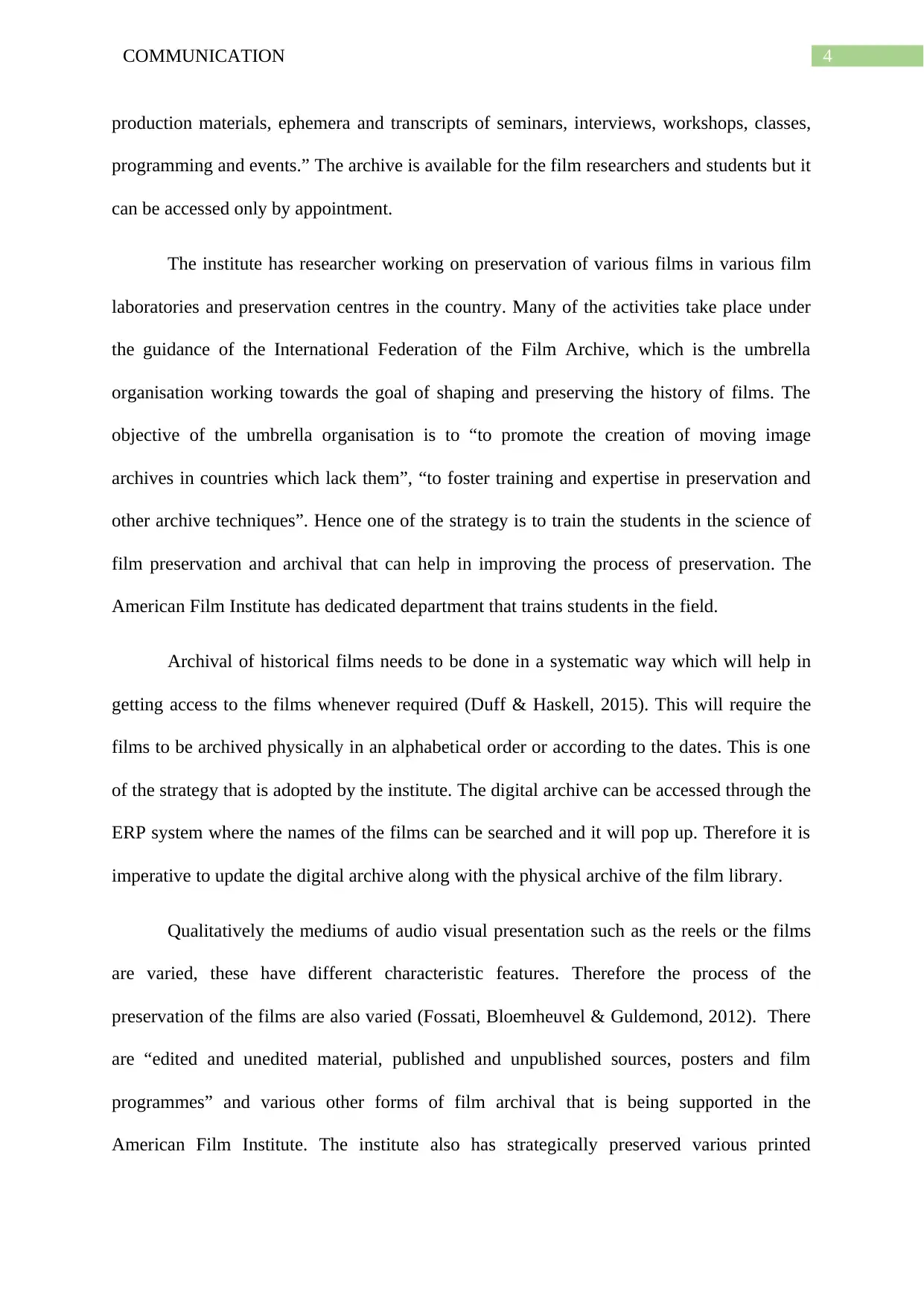
4COMMUNICATION
production materials, ephemera and transcripts of seminars, interviews, workshops, classes,
programming and events.” The archive is available for the film researchers and students but it
can be accessed only by appointment.
The institute has researcher working on preservation of various films in various film
laboratories and preservation centres in the country. Many of the activities take place under
the guidance of the International Federation of the Film Archive, which is the umbrella
organisation working towards the goal of shaping and preserving the history of films. The
objective of the umbrella organisation is to “to promote the creation of moving image
archives in countries which lack them”, “to foster training and expertise in preservation and
other archive techniques”. Hence one of the strategy is to train the students in the science of
film preservation and archival that can help in improving the process of preservation. The
American Film Institute has dedicated department that trains students in the field.
Archival of historical films needs to be done in a systematic way which will help in
getting access to the films whenever required (Duff & Haskell, 2015). This will require the
films to be archived physically in an alphabetical order or according to the dates. This is one
of the strategy that is adopted by the institute. The digital archive can be accessed through the
ERP system where the names of the films can be searched and it will pop up. Therefore it is
imperative to update the digital archive along with the physical archive of the film library.
Qualitatively the mediums of audio visual presentation such as the reels or the films
are varied, these have different characteristic features. Therefore the process of the
preservation of the films are also varied (Fossati, Bloemheuvel & Guldemond, 2012). There
are “edited and unedited material, published and unpublished sources, posters and film
programmes” and various other forms of film archival that is being supported in the
American Film Institute. The institute also has strategically preserved various printed
production materials, ephemera and transcripts of seminars, interviews, workshops, classes,
programming and events.” The archive is available for the film researchers and students but it
can be accessed only by appointment.
The institute has researcher working on preservation of various films in various film
laboratories and preservation centres in the country. Many of the activities take place under
the guidance of the International Federation of the Film Archive, which is the umbrella
organisation working towards the goal of shaping and preserving the history of films. The
objective of the umbrella organisation is to “to promote the creation of moving image
archives in countries which lack them”, “to foster training and expertise in preservation and
other archive techniques”. Hence one of the strategy is to train the students in the science of
film preservation and archival that can help in improving the process of preservation. The
American Film Institute has dedicated department that trains students in the field.
Archival of historical films needs to be done in a systematic way which will help in
getting access to the films whenever required (Duff & Haskell, 2015). This will require the
films to be archived physically in an alphabetical order or according to the dates. This is one
of the strategy that is adopted by the institute. The digital archive can be accessed through the
ERP system where the names of the films can be searched and it will pop up. Therefore it is
imperative to update the digital archive along with the physical archive of the film library.
Qualitatively the mediums of audio visual presentation such as the reels or the films
are varied, these have different characteristic features. Therefore the process of the
preservation of the films are also varied (Fossati, Bloemheuvel & Guldemond, 2012). There
are “edited and unedited material, published and unpublished sources, posters and film
programmes” and various other forms of film archival that is being supported in the
American Film Institute. The institute also has strategically preserved various printed
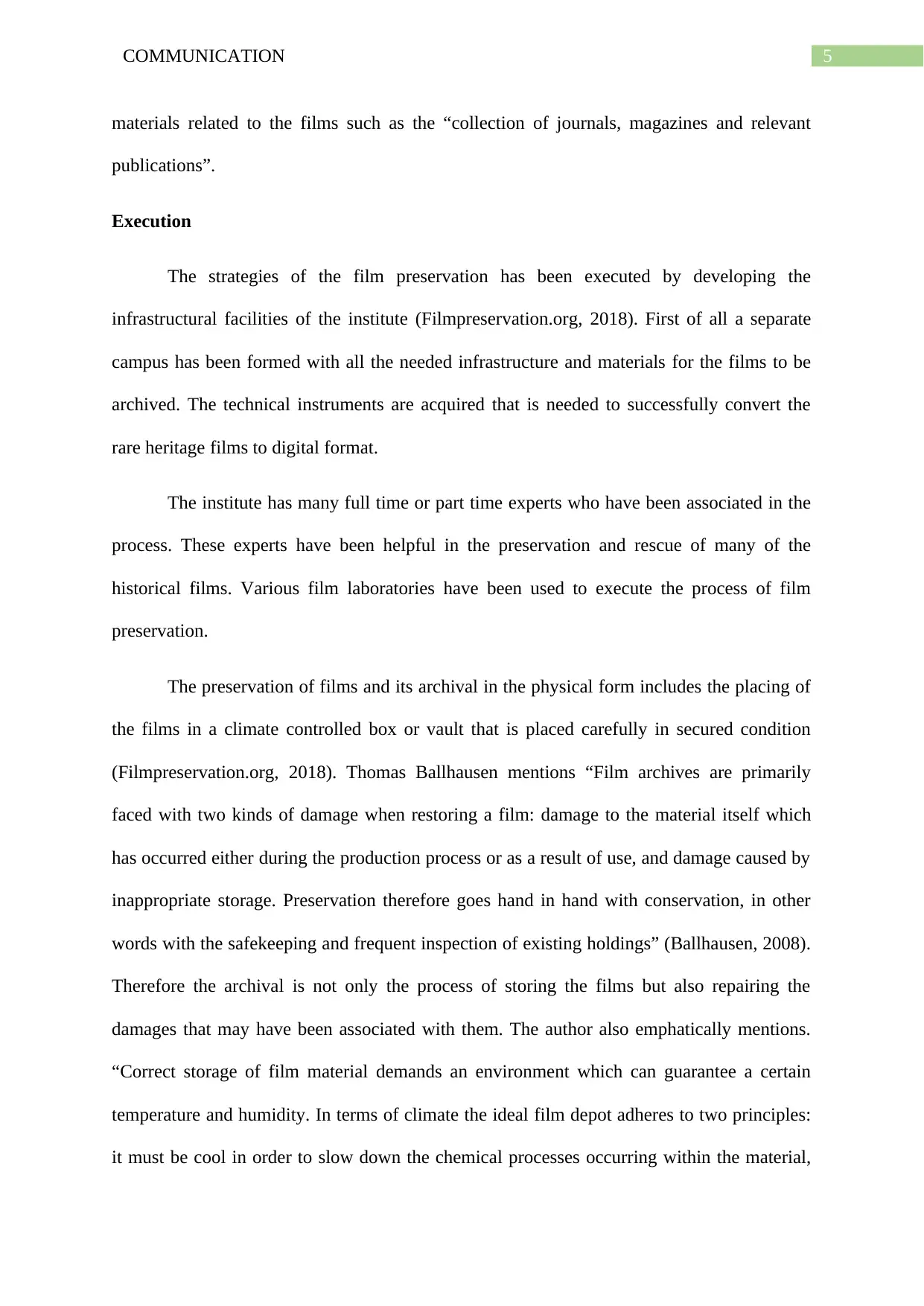
5COMMUNICATION
materials related to the films such as the “collection of journals, magazines and relevant
publications”.
Execution
The strategies of the film preservation has been executed by developing the
infrastructural facilities of the institute (Filmpreservation.org, 2018). First of all a separate
campus has been formed with all the needed infrastructure and materials for the films to be
archived. The technical instruments are acquired that is needed to successfully convert the
rare heritage films to digital format.
The institute has many full time or part time experts who have been associated in the
process. These experts have been helpful in the preservation and rescue of many of the
historical films. Various film laboratories have been used to execute the process of film
preservation.
The preservation of films and its archival in the physical form includes the placing of
the films in a climate controlled box or vault that is placed carefully in secured condition
(Filmpreservation.org, 2018). Thomas Ballhausen mentions “Film archives are primarily
faced with two kinds of damage when restoring a film: damage to the material itself which
has occurred either during the production process or as a result of use, and damage caused by
inappropriate storage. Preservation therefore goes hand in hand with conservation, in other
words with the safekeeping and frequent inspection of existing holdings” (Ballhausen, 2008).
Therefore the archival is not only the process of storing the films but also repairing the
damages that may have been associated with them. The author also emphatically mentions.
“Correct storage of film material demands an environment which can guarantee a certain
temperature and humidity. In terms of climate the ideal film depot adheres to two principles:
it must be cool in order to slow down the chemical processes occurring within the material,
materials related to the films such as the “collection of journals, magazines and relevant
publications”.
Execution
The strategies of the film preservation has been executed by developing the
infrastructural facilities of the institute (Filmpreservation.org, 2018). First of all a separate
campus has been formed with all the needed infrastructure and materials for the films to be
archived. The technical instruments are acquired that is needed to successfully convert the
rare heritage films to digital format.
The institute has many full time or part time experts who have been associated in the
process. These experts have been helpful in the preservation and rescue of many of the
historical films. Various film laboratories have been used to execute the process of film
preservation.
The preservation of films and its archival in the physical form includes the placing of
the films in a climate controlled box or vault that is placed carefully in secured condition
(Filmpreservation.org, 2018). Thomas Ballhausen mentions “Film archives are primarily
faced with two kinds of damage when restoring a film: damage to the material itself which
has occurred either during the production process or as a result of use, and damage caused by
inappropriate storage. Preservation therefore goes hand in hand with conservation, in other
words with the safekeeping and frequent inspection of existing holdings” (Ballhausen, 2008).
Therefore the archival is not only the process of storing the films but also repairing the
damages that may have been associated with them. The author also emphatically mentions.
“Correct storage of film material demands an environment which can guarantee a certain
temperature and humidity. In terms of climate the ideal film depot adheres to two principles:
it must be cool in order to slow down the chemical processes occurring within the material,
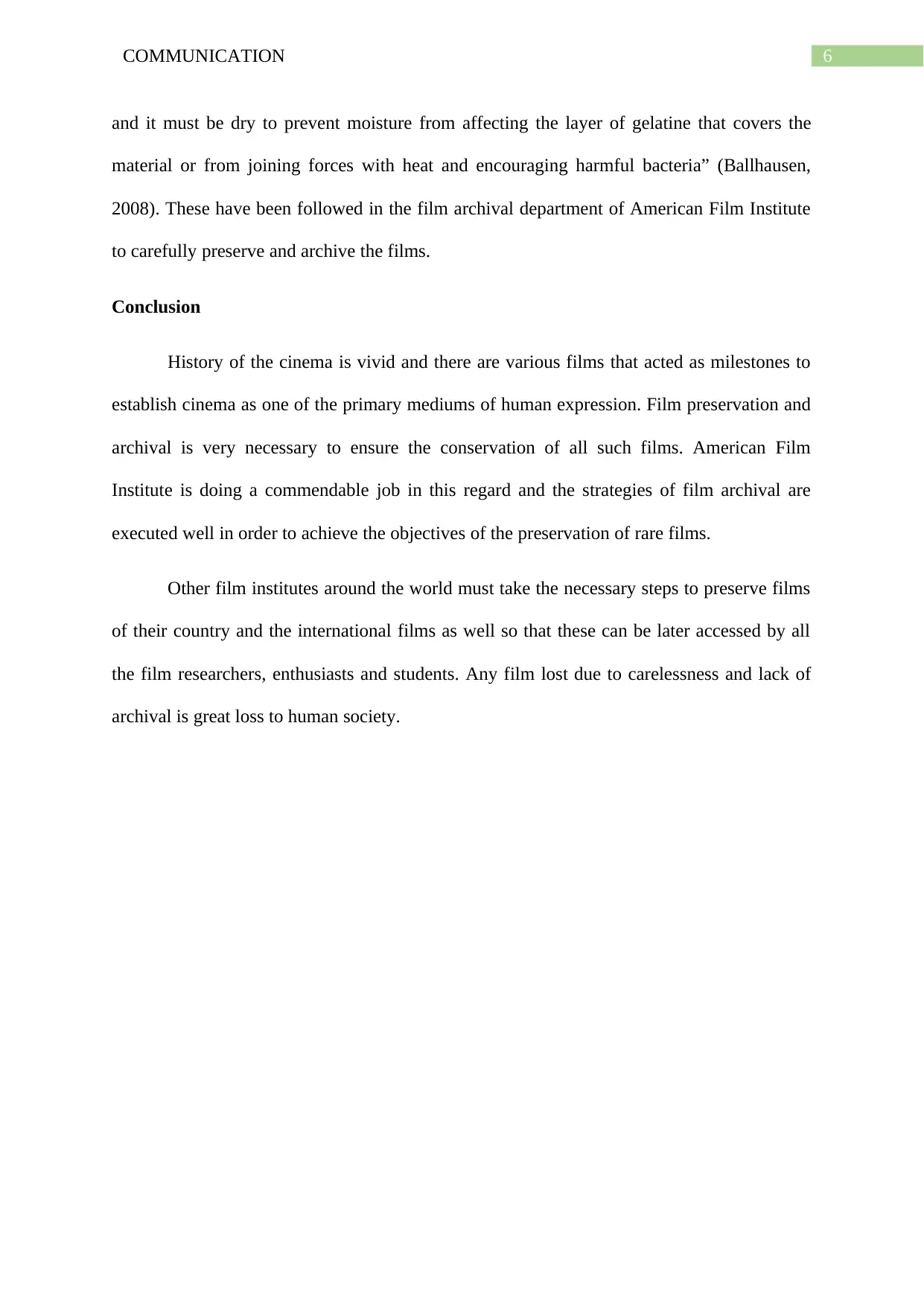
6COMMUNICATION
and it must be dry to prevent moisture from affecting the layer of gelatine that covers the
material or from joining forces with heat and encouraging harmful bacteria” (Ballhausen,
2008). These have been followed in the film archival department of American Film Institute
to carefully preserve and archive the films.
Conclusion
History of the cinema is vivid and there are various films that acted as milestones to
establish cinema as one of the primary mediums of human expression. Film preservation and
archival is very necessary to ensure the conservation of all such films. American Film
Institute is doing a commendable job in this regard and the strategies of film archival are
executed well in order to achieve the objectives of the preservation of rare films.
Other film institutes around the world must take the necessary steps to preserve films
of their country and the international films as well so that these can be later accessed by all
the film researchers, enthusiasts and students. Any film lost due to carelessness and lack of
archival is great loss to human society.
and it must be dry to prevent moisture from affecting the layer of gelatine that covers the
material or from joining forces with heat and encouraging harmful bacteria” (Ballhausen,
2008). These have been followed in the film archival department of American Film Institute
to carefully preserve and archive the films.
Conclusion
History of the cinema is vivid and there are various films that acted as milestones to
establish cinema as one of the primary mediums of human expression. Film preservation and
archival is very necessary to ensure the conservation of all such films. American Film
Institute is doing a commendable job in this regard and the strategies of film archival are
executed well in order to achieve the objectives of the preservation of rare films.
Other film institutes around the world must take the necessary steps to preserve films
of their country and the international films as well so that these can be later accessed by all
the film researchers, enthusiasts and students. Any film lost due to carelessness and lack of
archival is great loss to human society.
Paraphrase This Document
Need a fresh take? Get an instant paraphrase of this document with our AI Paraphraser
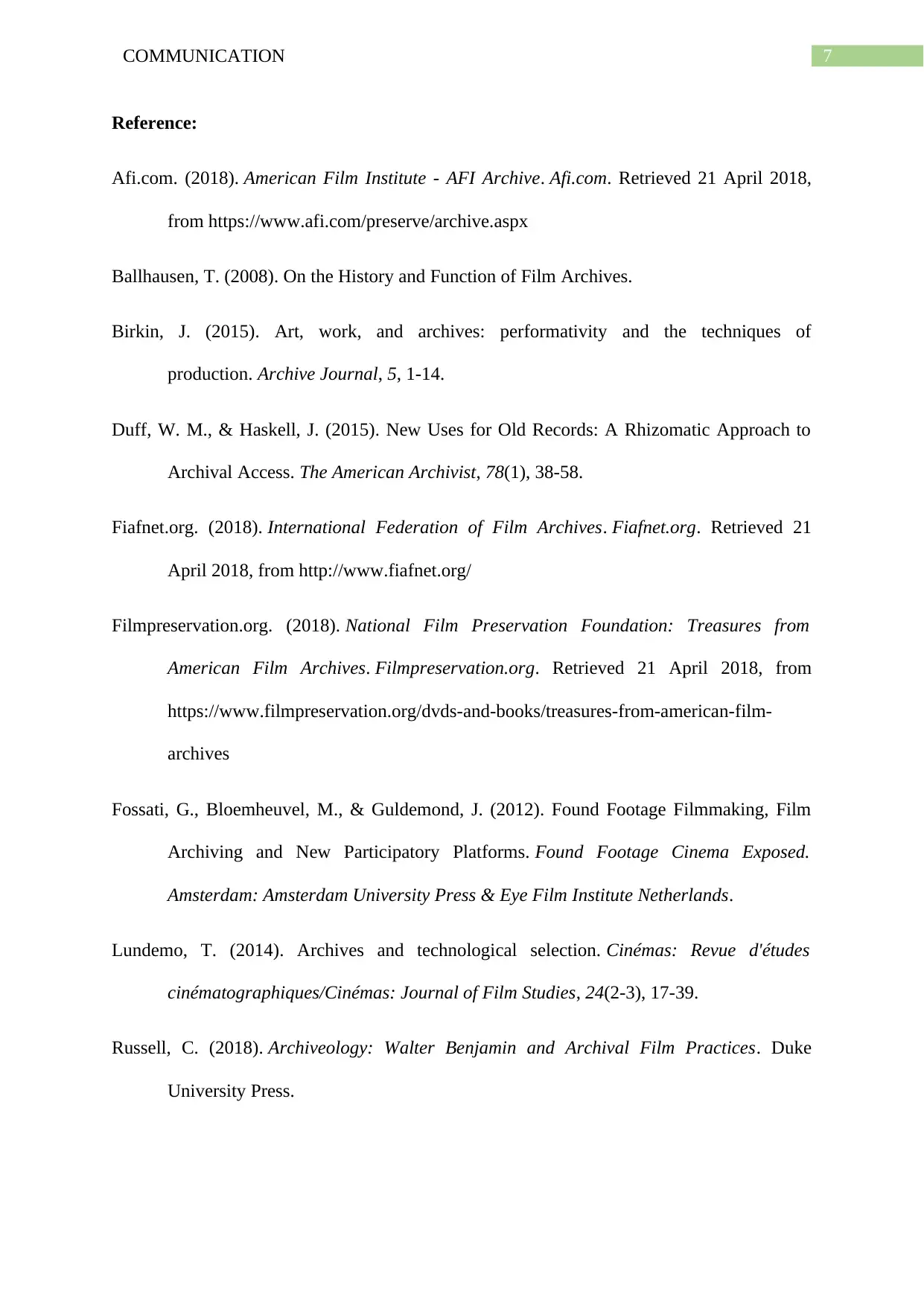
7COMMUNICATION
Reference:
Afi.com. (2018). American Film Institute - AFI Archive. Afi.com. Retrieved 21 April 2018,
from https://www.afi.com/preserve/archive.aspx
Ballhausen, T. (2008). On the History and Function of Film Archives.
Birkin, J. (2015). Art, work, and archives: performativity and the techniques of
production. Archive Journal, 5, 1-14.
Duff, W. M., & Haskell, J. (2015). New Uses for Old Records: A Rhizomatic Approach to
Archival Access. The American Archivist, 78(1), 38-58.
Fiafnet.org. (2018). International Federation of Film Archives. Fiafnet.org. Retrieved 21
April 2018, from http://www.fiafnet.org/
Filmpreservation.org. (2018). National Film Preservation Foundation: Treasures from
American Film Archives. Filmpreservation.org. Retrieved 21 April 2018, from
https://www.filmpreservation.org/dvds-and-books/treasures-from-american-film-
archives
Fossati, G., Bloemheuvel, M., & Guldemond, J. (2012). Found Footage Filmmaking, Film
Archiving and New Participatory Platforms. Found Footage Cinema Exposed.
Amsterdam: Amsterdam University Press & Eye Film Institute Netherlands.
Lundemo, T. (2014). Archives and technological selection. Cinémas: Revue d'études
cinématographiques/Cinémas: Journal of Film Studies, 24(2-3), 17-39.
Russell, C. (2018). Archiveology: Walter Benjamin and Archival Film Practices. Duke
University Press.
Reference:
Afi.com. (2018). American Film Institute - AFI Archive. Afi.com. Retrieved 21 April 2018,
from https://www.afi.com/preserve/archive.aspx
Ballhausen, T. (2008). On the History and Function of Film Archives.
Birkin, J. (2015). Art, work, and archives: performativity and the techniques of
production. Archive Journal, 5, 1-14.
Duff, W. M., & Haskell, J. (2015). New Uses for Old Records: A Rhizomatic Approach to
Archival Access. The American Archivist, 78(1), 38-58.
Fiafnet.org. (2018). International Federation of Film Archives. Fiafnet.org. Retrieved 21
April 2018, from http://www.fiafnet.org/
Filmpreservation.org. (2018). National Film Preservation Foundation: Treasures from
American Film Archives. Filmpreservation.org. Retrieved 21 April 2018, from
https://www.filmpreservation.org/dvds-and-books/treasures-from-american-film-
archives
Fossati, G., Bloemheuvel, M., & Guldemond, J. (2012). Found Footage Filmmaking, Film
Archiving and New Participatory Platforms. Found Footage Cinema Exposed.
Amsterdam: Amsterdam University Press & Eye Film Institute Netherlands.
Lundemo, T. (2014). Archives and technological selection. Cinémas: Revue d'études
cinématographiques/Cinémas: Journal of Film Studies, 24(2-3), 17-39.
Russell, C. (2018). Archiveology: Walter Benjamin and Archival Film Practices. Duke
University Press.
1 out of 8
Your All-in-One AI-Powered Toolkit for Academic Success.
+13062052269
info@desklib.com
Available 24*7 on WhatsApp / Email
![[object Object]](/_next/static/media/star-bottom.7253800d.svg)
Unlock your academic potential
© 2024 | Zucol Services PVT LTD | All rights reserved.